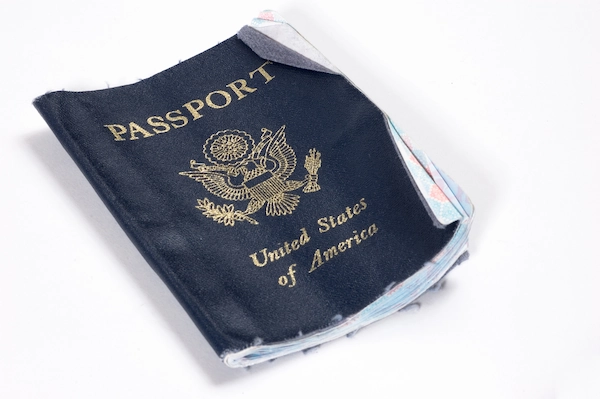Can You Travel With a Damaged U.S. Passport?

Your passport must be in good condition to serve as a valid proof of identity. Yet many travelers only realize the importance of this after discovering a bent cover, loose page, or watermark right before a trip.

Can you travel with a broken passport, or will you be denied boarding? This article clarifies what counts as “damage”, how to replace a damaged passport, and where to get a compliant passport photo.
Table of contents
- Why passport condition important
- Can you fly with a slightly damaged passport?
- Can you fly home to the USA with a damaged passport?
- Can you travel with a ripped passport?
- Can you travel with a damaged passport cover?
- Passport got wet but not damaged: what to do
- Damaged passport replacement: how to renew or replace
- USA Passport Photo Editor
- USA Passport Photo App
- Damaged passport letter: do you need one?
- Preventing passport damage: useful tips
Why passport condition important
The state of your passport is vital because a passport that is damaged, altered, or overly worn may not be accepted for international travel. Airlines or border officers might deny boarding or entry if the passport is judged unsuitable.
Most countries insist on passports being free of damage beyond normal aging, ensuring that identification data, photographs, and security features can be verified accurately. This requirement helps governments and airlines confirm the passport's authenticity and match it to the traveler, enhancing both individual and global safety measures.
What is considered a damaged passport in the USA? In the United States, a passport is considered damaged if its structure, content, or microchip shows noticeable deviations from the original design, hindering its function as proof of identity and citizenship. This includes:
- damage from water or other liquids, causing pages to curl or warp;
- pages or covers that are torn, ripped, or cut;
- mutilations such as creases, animal bites, or severe warping;
- ink on the information or photo page that is faded, smudged, or blotchy;
- peeling lamination on the page displaying personal data;
- covers or bindings that are loose or missing;
- unauthorized markings or stickers on any pages;
- damage to the RFID chip embedded within.
How damaged is too damaged passport? A U.S. passport is classified as "too damaged" if the harm affects crucial aspects such as the personal details, photo page, security features, or machine-readable zone. If a passport reaches this extent of damage, it cannot be renewed by mail and must be replaced in person using Form DS-11, accompanied by a signed letter of explanation. Minor issues like slight creasing or mild fading typically do not warrant immediate replacement.
Can you fly with a slightly damaged passport?
Can I fly with a slightly damaged passport? Flying with a slightly damaged passport can be risky because airlines and immigration officials often enforce strict guidelines regarding passport conditions. Minor issues like small tears, water stains, creases, or smudges on key pages might lead to you being denied boarding by the airline or refused entry by immigration officers.
Airlines have a legal responsibility to ensure that passengers have valid travel documents. If they allow a traveler with a damaged passport to board and that individual is then denied entry at the destination, the airline can face penalties. Consequently, airlines are usually cautious and may refuse boarding for even small damages. Even if you do make it onto the flight, some countries have strict policies against damaged passports, possibly resulting in denied entry and the expense of a return trip.
Can you fly home to the USA with a damaged passport?
Flying to the USA with a damaged passport is typically not permitted. Airlines and border officials might deny boarding or entry if the damage is substantial, particularly if it affects crucial areas like the personal data or photo page or the machine-readable section.
If a U.S. citizen abroad finds their passport damaged, they should contact the nearest U.S. embassy or consulate. There, a limited-validity emergency passport can be issued to facilitate return travel to the U.S. However, this emergency passport is typically only for a single-entry trip home and needs to be replaced once back in the U.S.
Can you travel with a ripped passport?
Traveling with a ripped passport is generally not advisable and poses significant risks. A ripped passport is considered damaged, especially if the tear impacts vital areas like the photo page, biographical data, or the machine-readable zone. Airlines are legally obligated to ensure passengers have valid travel documents and may refuse boarding if a passport is ripped. Similarly, border control officials can deny entry if the passport is torn or compromised.
What to do if my dog chewed my passport? If your dog chews your passport, it's considered damaged, and you shouldn't attempt to travel with it. Replacing a dog-chewed passport follows the same process as any damaged passport, and it's important to act promptly to avoid travel interruptions.
Can you travel with a damaged passport cover?
Traveling with a passport that has a damaged cover might be acceptable in some cases, depending on how badly it's affected and whether it compromises the passport's overall integrity and usability. Minor wear or damage to just the cover usually won’t invalidate the passport, as long as the essential internal pages - particularly the photo page and biographical data - remain clear and undamaged.
Passport got wet but not damaged: what to do
Can you travel with a water-damaged passport? If water affects your passport's readability, personal information, photo page, or security elements like the RFID chip, it cannot be used for international travel.
If your passport has been exposed to water but appears undamaged (with no smudged ink, no torn pages, and an intact information page), follow these steps:
- Gently dry the passport using paper towels or a clean cloth, avoiding high heat such as a hairdryer, which could cause more damage.
- Inspect the passport thoroughly for any signs of damage, like ink bleeding, warped pages, or compromised security features, including the embedded chip.
- Even if the passport seems fine, be cautious, as border control scanners might detect internal damage not visible to the eye.
- Contact the passport-issuing authority (such as the U.S. Department of State) or visit the nearest embassy or consulate for a professional check and advice on whether a replacement is needed.
- If there is any doubt about the passport's condition, especially with imminent travel plans, refrain from traveling. A water-exposed passport can still be considered damaged and might be rejected at airports or border control.
- If the passport is determined to be damaged or at risk, promptly apply for a new one to avoid disrupting your travel.
Damaged passport replacement: how to renew or replace
Can I replace a damaged passport? Absolutely! Here is a step-by-step guide to the replacement process:
- Prepare the following documents required for the reissue of a damaged passport:
- Proof of U.S. citizenship (such as a birth certificate or an expired passport).
- Filled out Form DS-11 (application for a new U.S. passport).
- A photocopy of a government-issued photo ID (like a driver’s license).
- One recent 2×2-inch passport photo that meets government standards.
- A signed explanation detailing how the passport was damaged.
- Receipt for fee payment. The damaged passport replacement prices are USD 130 for the passport, plus a USD 35 passport acceptance agent fee. An additional USD 60 is required for expedited service, if applicable.
- Find the nearest facility, such as a post office, library, or government office, and make an appointment. If your passport is damaged abroad, visit the nearest U.S. embassy or consulate to apply for an emergency passport or a replacement.
- Submit your application in person. At your appointment, bring the damaged passport, all required documents, and the necessary fees to apply.
Standard processing takes about 6 to 9 weeks. Expedited processing is faster, typically taking 3 to 5 weeks.
USA Passport Photo Editor
For the most reliable passport photos, consider using specialized online tools. Visafoto has been assisting with document photos since 2013 and is knowledgeable about requirements for all types of documents worldwide, including passports, visas, and driving licenses.
With Visafoto, you can take a passport photo for a U.S. passport application from anywhere. Just follow the instructions to take a picture and upload it to our website. All the technical details, including background, size, and dimensions, are taken care of automatically.
Here is an example of a photo you may upload:

You'll get both a digital copy for online applications and a print-ready version. If you’re dissatisfied with the result, we will replace the photo for free. If the photo is rejected by officials, we offer a full refund.


USA Passport Photo App



Prefer using your phone? Another great tool for creating professional U.S. passport photos is the 7ID App by Visafoto.com. This user-friendly app lets you make ID, passport, and visa photos directly from your phone and is available for both iPhone and Android users.
Using 7ID is straightforward: upload your photo, specify that you need a U.S. passport photo, and the app automatically adjusts it to meet official standards. This includes getting the size, format, background color, and facial alignment right.
You’ll receive a digital copy and a print template compatible with popular paper sizes like 4×6, A4, A5, or B5. For any questions or help, our technical support team is readily available.
Damaged passport letter: do you need one?
When you're replacing a damaged U.S. passport, it's usually necessary to include a signed letter or statement explaining a damage passport. This letter should:
- be directed to the U.S. Department of State;
- contain your full name and passport number;
- clearly explain how the damage happened, such as through water exposure, torn pages, or accidental mishandling;
- include your original ink signature.
This letter provides an official account of the passport’s condition and must be submitted with your completed DS-11 application form, the damaged passport itself, all supporting identification documents, and the relevant fees.
Preventing passport damage: useful tips
Here are some practical tips to help keep your passport in excellent condition:
- Use a passport cover. Protect your passport by using a durable, ideally waterproof cover to guard against spills, creases, and general wear.
- Store safely. Always place your passport in a dry, secure section of your carry-on bag or personal item. Avoid places like pockets that might end up in the laundry, or where it can get bent or squashed.
- Keep away from pets and children. Since pets and small children can unintentionally chew or spill on passports, store it safely out of their reach.
- Avoid moisture and humidity. Water damage is a frequent reason passports become invalid. Use waterproof pouches during beach or outdoor excursions and keep them away from damp areas.
- Do not bend or fold. Excessive bending or folding can cause the lamination to peel or crease important pages, potentially rendering the passport unusable.
- Shield from the sun and heat. Extended exposure to sunlight or high temperatures can harm the passport chip or fade the information page.
- Keep it secure and discreet. Always carry your passport securely on your person, like in a hidden travel wallet or money belt, to prevent it being lost or stolen.
- Make copies. Retain photocopies or digital backups of the passport's information page separately to facilitate replacement if it's ever lost or stolen.
- Stay vigilant in crowded areas. Protect your passport in busy or high-risk places to avoid falling victim to pickpocketing.
Last updated: 2025-10-17
